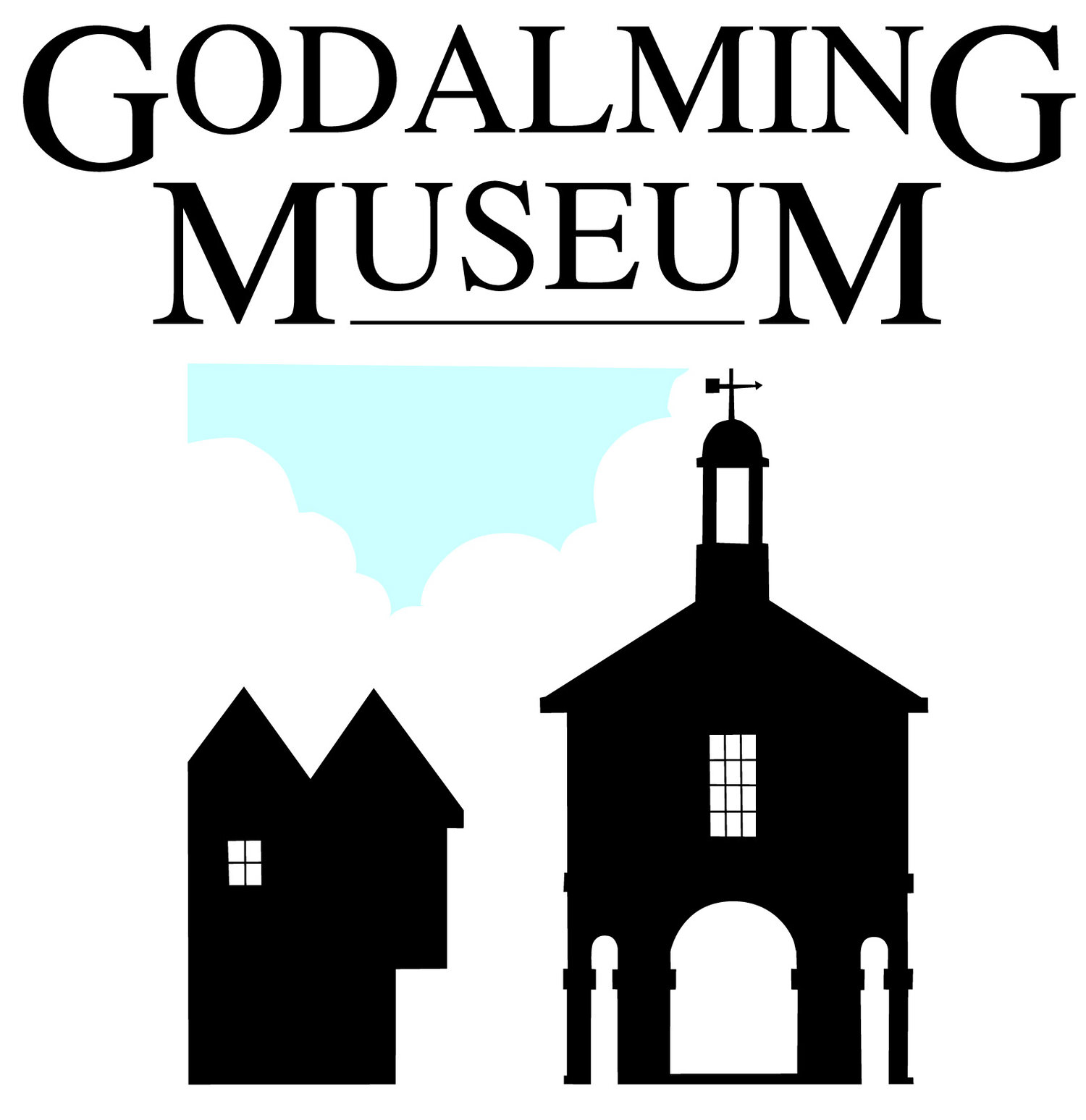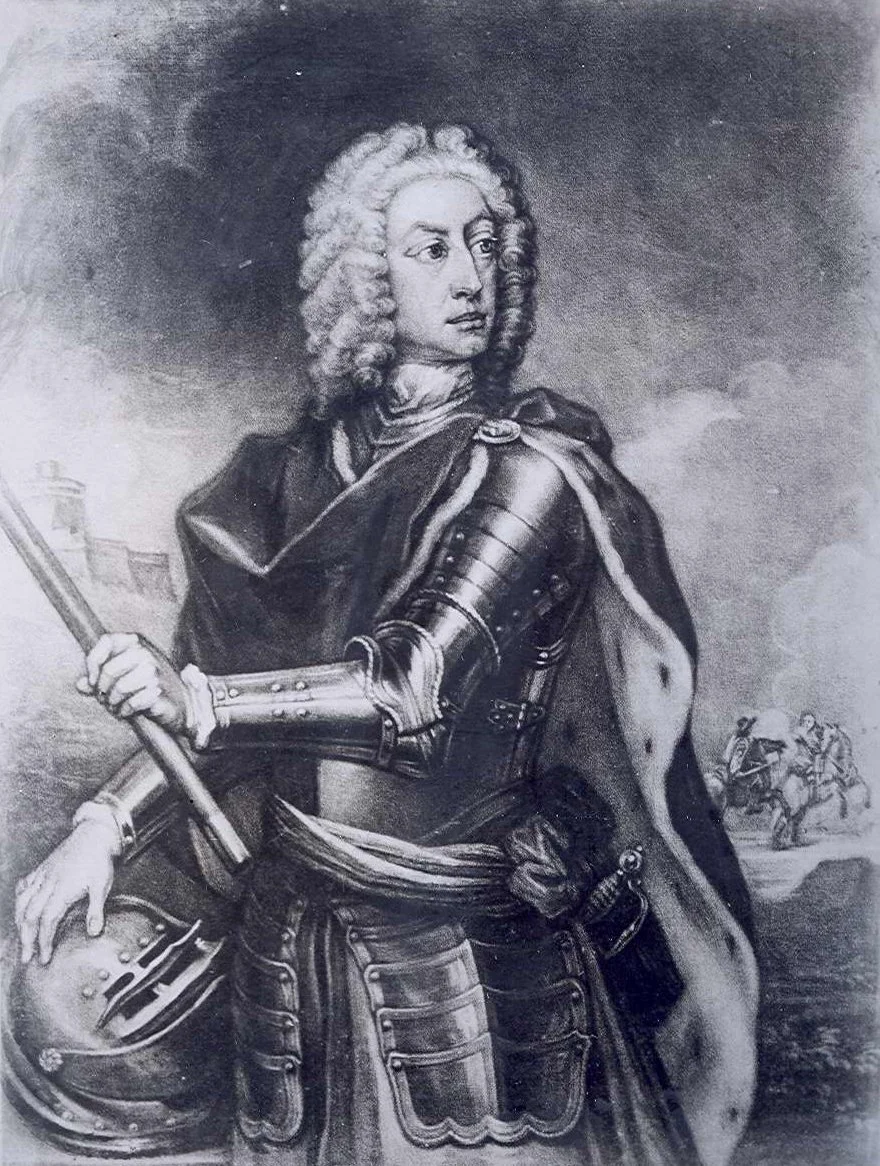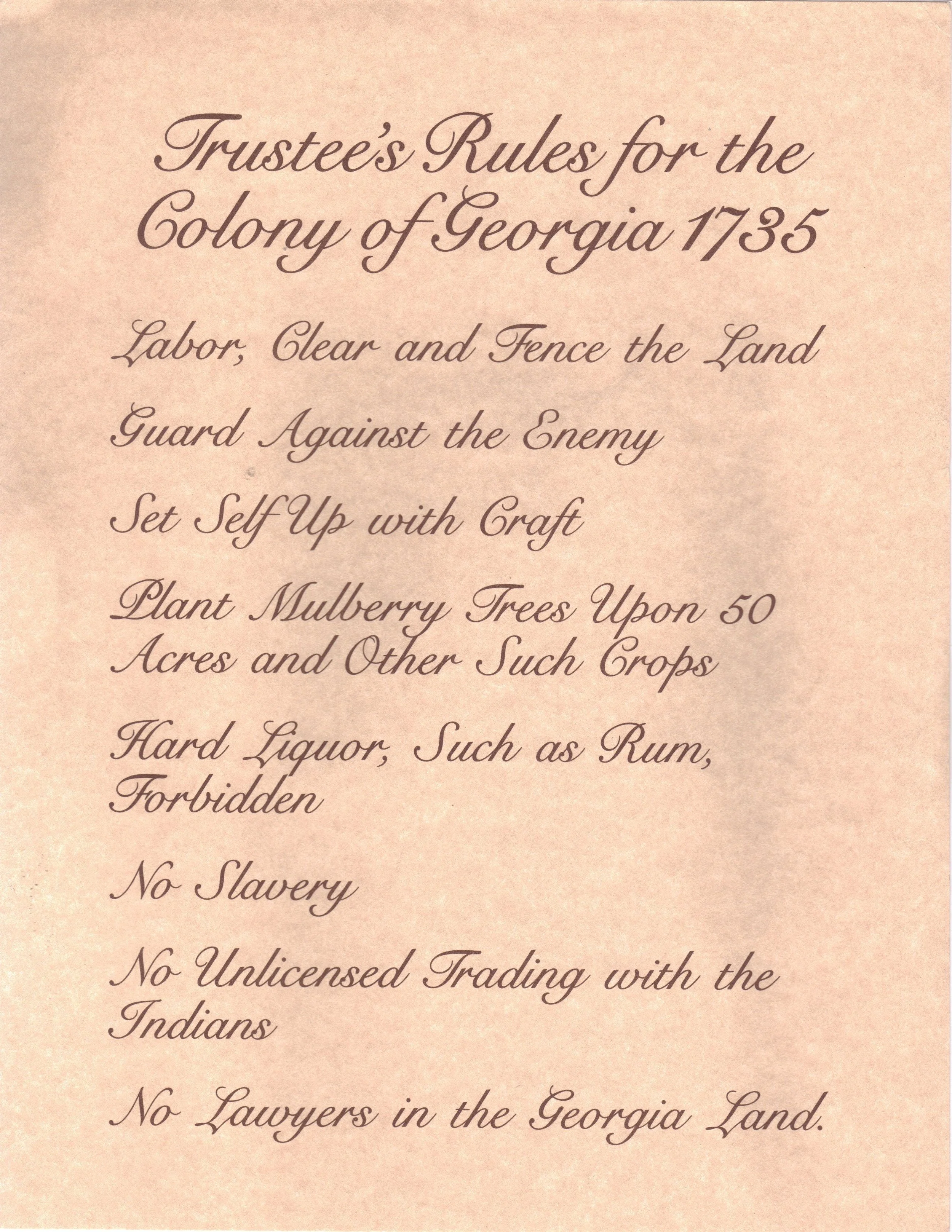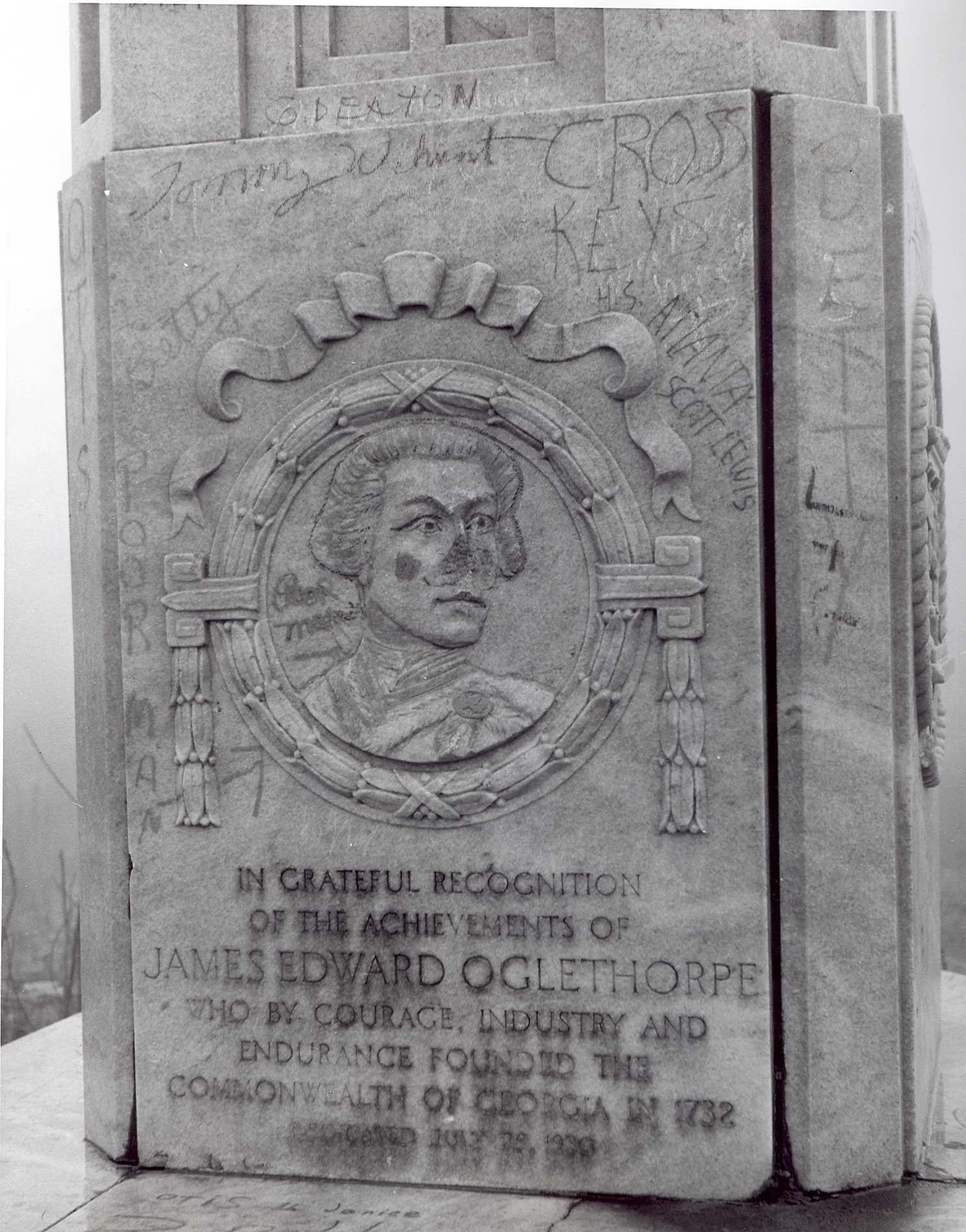James Edward Oglethorpe (1696-1785)
In July 1688, Sir Theophilus Oglethorpe purchased the Manors of Westbroke and Binscombe, and the house known as Westbroke Place. Theophilus had returned to Godalming and, in the late autumn of 1696, took the oath of loyalty to William III. The year was also marked for Theophilus and Eleanor, by the birth of James Edward Oglethorpe, their tenth and last child, on December 22nd 1696. He was born in London, and christened the following day at St. Martin’s-in-the-Fields Church by the Archbishop of Canterbury.
General James Edward Oglethorpe as a young man
Mounted black and white photograph of the portrait of General James Edward Oglethorpe as a young man, clad in armour, at the time when he was serving as aide-de-camp to Prince Eugene, at the Battle of Belgrade.
He had been enrolled into Queen Anne’s 1st Regiment of Foot Guards when only ten years old, but this was mainly a ceremonial regiment. Oglethorpe had some education at Eton, and in 1714 he entered Corpus Christi College, Oxford.
He entered the military academy at Lompres, near Paris, and in 1716 war between the Turks and Austrians gave him the chance to enroll with the Austrian Imperial army under Prince Eugene of Savoy. As a young man he served in Germany and Hungary under Prince Eugene, to whom he was secretary and aide-de-camp. He fought in 1716 at the battle of Petrovardin, and in the siege of Timisora. In 1717 he fought the Turks at the battle of Belgrade.
The Battle of Petrovaradin 1716
Painting of the Battle of Petrovaradin 1716 by Georg Philipp Rugendas the Elder (1666 – 1742) courtesy of Wikimedia Commons.
In 1718, as he was the remaining son, Oglethorpe came into his inheritance at Westbrook, at the age of 22. His five brothers had all died, three in infancy, and his four sisters, who were alive, were not allowed to inherit. At the age of 25, in 1722, he became in his turn a candidate for Parliament, and was elected Member of Parliament for Haslemere, following his father, and two brothers. He continued to serve being successful in the elections in 1727, 1734, 1741 and 1747 but lost his seat in 1754.
When Oglethorpe became Member of Parliament he soon became aware of causes needing correction - one special cause was the condition and management of the English prisons. He gathered together a band of like-minded Parliamentarians, and pressed for the formation of a special committee to draw up suitable legislation - the committee was formed and Oglethorpe became its Chairman in 1729 to enquire into the state of the British prisons. The group held many meetings most of which took place at Westbrook, and the house became noted for social and political gatherings. A measure was duly introduced into Parliament, which resulted in an improvement in prison conditions, the release of many short-time debtors and the removal of some of the worst warders and overseers.
Mrs. Fry Reading to the Prisoners in Newgate, in the Year 1816
An engraving by Jerry Barrett, published 1 May 1863. Elizabeth Fry was another well-known campaigner for prison reform. Image courtesy of Open Learn.
Oglethorpe conceived the idea of founding a thirteenth British colony in America, and as a place for those who were poverty-stricken Britons and European refugees, and of religious tolerance. It was a philanthropic move but also it was seen as a military tactic to protect the established colonies of New Bern and Charleston (now North and South Carolina). Oglethorpe formed the Georgia Society in 1730, which petitioned “that the cities of London, Westminster, and parts adjacent, do abound with great numbers of indigent persons, who are reduced to such necessity as to become burthensome to the public, and who could be willing to seek a livelihood in any part of his Majesty’s plantations in America, if they were provided with passage, and means of settling there.”
The official charter to establish the colony was signed on the 21st April 1732 by King George II to “the Trustees for establishing the Colony of Georgia in America.”
Oglethorpe may have ascertained that the mulberry tree flourished in the area where he contemplated setting up the new colony, and so he trained many of his prospective settlers in the care of the silkworm, the winding preparation and use of the silken thread. For this purpose he brought over a number of experts from Italy to train his workers. He also had experience of growing vines at Westbrook Place and Godalming already had a thriving woollen industry on which the prosperity of the town depended. He chose his settlers wisely including all trades and professions to establish a working colony of people.
The first 115 settlers sailed with Oglethorpe in 1732, on the 17th November, from Gravesend in the ship Ann. The families consisted of the mid-age range 30-50 with husband and a wife and with one to four children.
Trustees Rules for the Colony of Georgia, 1735
Modern production, notice of the Trustees Rules for the Colony of Georgia, 1735,
It took them two months before they arrived at Charleston, South Carolina, on the 13th January 1733. Oglethorpe, after looking for a suitable location and finding Yamacraw Bluffs on the Savannah River in Georgia, returned to the colonists. They made their way reaching the site on the 12th February 1733 (new style) to make their settlement, and set about laying out a rectangular plan for their town of Savannah in the new colony of Georgia. In the summer of 1733 more colonists arrived, including Moravians in 1735. As well as enlisting fresh settlers for the new colony, Oglethorpe returned to England in May 1734 to raise further funds for extending his work in Georgia.
Memorial to General James Oglethorpe erected on Mount Oglethorpe, Georgia
Mounted black and white photograph of the memorial to General James Oglethorpe erected on Mount Oglethorpe, Georgia, 28th July 1930. Detail of the plinth. The memorial itself is a 38 ft high shaft of marble, given by Col Sam Tate, President of the Georgia Marble Company. Photograph by the Atlanta Journal and Constitution Magazine
Oglethorpe had befriended the Native Americans, and had made an effort to know their customs, and to have good relationships with them. He had befriended the Mico, or Chief, Tomochichi, who was 16 years older.
When Oglethorpe returned to London he brought back with him ten Native Americans, members of the Yamacraw tribe - an outlawed tribe of the Creeks, - including the Yamacraw Chief, and his friend, Tomochichi, his wife, Scanauki, and his nephew and heir, Toonahowi. They were taken to Whitehall and Eton, and many other places where they caused quite a stir. Unfortunately during their stay in London one of the Native Americans Stimalchi, contracted smallpox. Oglethorpe’s friend, Sir Hans Sloane, physician, came to minister to him but he died. He was buried in the graveyard of St John the Evangelist Church in Smith Square, Westminster. The Native Americans “went to Mr Oglethorpe’s in Surrey to dissipate their sorrow”, and isolated themselves at Westbrook. Oglethorpe had them to stay at Westbrook for about four months. On one occasion, Oglethorpe caused a sensation in Godalming, by bringing the Native Americans to dine at the White Hart Inn.
Treaty Between Oglethorpe and Tomochichi at Savannah May 21 1733
Image courtesy of Atlanta History Photograph Collection.
In October 1735, Oglethorpe left for Georgia for a second time in the ‘Simmonds’, with the Wesley brothers and Ingham. Charles Wesley became Oglethorpe’s Secretary for Indian Affairs at Fredrica but left in July 1736 to return to England. John Wesley stayed on to found an orphanage, and became chaplain at Savannah but left in December 1737 to return to England, where he founded the Methodist Movement.
Oglethorpe captured St Augustine from the Spanish, and founded Augusta on the Savannah side, and Frederica Fort on St Simon’s island. In November 1736, after one year, Oglethorpe returned to London to raise funds for the colony.
In 1737 he was given a commission as General and Commander-in Chief for his Majesty’s provinces in South Carolina and Georgia. He returned for the third time in July 1738 with a volunteer muster of 600 soldiers. In 1739 war with Spain broke out.
In 1742 he defeated the Spanish who occupied the islands of Guale at the Battle of Bloody Marsh on St Simon’s Island, such that the Spanish were no longer a threat to Georgia and the British colonies. In 1743 Oglethorpe was promoted to Brigadier General, whereas before the title of General had been one of an honorary nature.
He was responsible for the first English resident on the island of Ospo and changed the name to ‘Jekyll Island’. One of Oglethorpe's friends, Sir Joseph Jekyll, Master of the Rolls (1662-1738) had donated £500 towards the settlement and Oglethorpe commemorated this gift by naming the coastal island after him. Joseph Jekyll was related to Gertrude Jekyll, the well-known gardener, who lived in Godalming.
Jekyll Island Hotel Resort, 1886
Photograph showing an annexe added to the Clubhouse at the Jekyll Island Club Resort in Georgia.
James Oglethorpe finally left Georgia on 23rd July 1743, returning to England to face various charges laid against him by disaffected colonists and others; he cleared himself of much of the calumny attached to his name and secured at last the repayment of his own monies (some £66,000) which he had used in establishing the colony.
In September 1744 in Westminster Abbey, Oglethorpe, at the age of 48, married an heiress, Lady Elizabeth Wright, daughter of Sir Nathan Wright of Cranham Hall in Essex. They spent their honeymoon at Westbrook, attended by a Chickasaw Indian Chief who had accompanied him to England. In due course the Oglethorpes settled at Elizabeth's home in Essex, and Westbrook saw little more of the Squire.
On March 30th, 1745, Oglethorpe was created Major General, to serve under the Duke of Cumberland. After subsequent manoeuvres and excursions Oglethorpe was eventually court-martialed for “lingering on the road” in December 1745, and was acquitted.
In 1747 he was promoted to Lieutenant General, but his career, as an active soldier was finished. And in 1765 he was appointed General, and was the senior general for the whole of the British Army.
General Oglethorpe at the sale of Dr Johnson's books, 18 February 1785
Mounted and framed engraving by Samuel Ireland.
After his acquittal James retired more and more from public affairs and turned his interest to becoming a patron of the arts. On the 9th November 1749 the Hon. Lieutenant General James Oglethorpe of Lisle Street, London (“a Gentleman well versed in Natural History, Mathematicks and all branches of Polite Literature”) was elected a Member of the Royal Society in London. Also on the same date, Philip Carteret Webb Esq, of Budge Row, London (“being a Gentm every way qualified to be an useful and valuable member”) was elected. Oglethorpe had a country home at Westbrook and Webb had his at Busbridge Hall, they were neighbours.
These two men were to meet again when they contested the Parliamentary seat for Haslemere. Webb along with James More Molyneux stood jointly for the election, building support by the conversion of leaseholds into freeholds, and they were elected in April 1754, defeating James Edward Oglethorpe and Peter Burrel. Oglethorpe had held the seat for 32 years since 1722 and had seen seven parliaments.
It was at Oglethorpe’s instigation, as one of the trustees and executors of his friend, Sir Hans Sloane, that the Government purchase the Sloane Collection, which became the nucleus of the British Museum.
Oglethorpe died on 30th June 1785, in his 89th year. General James Oglethorpe lived to a great age with a very fine and full record of service to Westbrook, to the state of Georgia, which he founded, and to his native country. He is buried in the Chancel of All Saints, Cranham, near Upminster, Essex.








